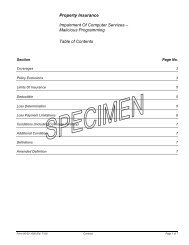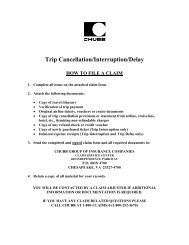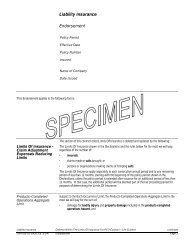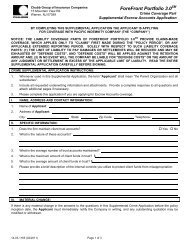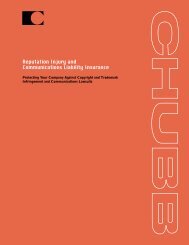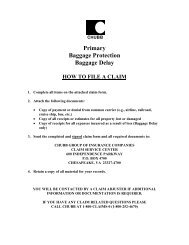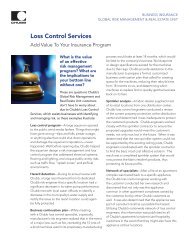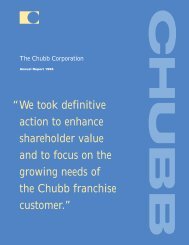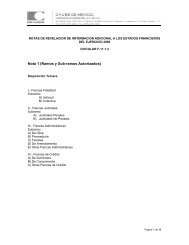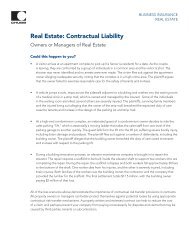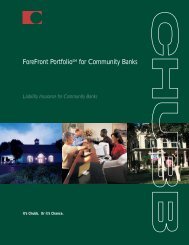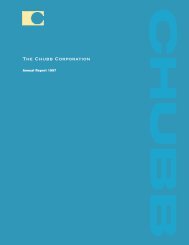Annual Report 2005 - Chubb Group of Insurance Companies
Annual Report 2005 - Chubb Group of Insurance Companies
Annual Report 2005 - Chubb Group of Insurance Companies
Create successful ePaper yourself
Turn your PDF publications into a flip-book with our unique Google optimized e-Paper software.
At December 31, 2004<br />
Total<br />
Estimated<br />
There- Amortized Market<br />
<strong>2005</strong> 2006 2007 2008 2009 after Cost Value<br />
(in millions)<br />
Tax-exempt ÏÏÏÏÏÏÏÏÏÏÏÏÏÏÏÏÏÏÏ $1,020 $ 547 $ 756 $ 846 $1,010 $9,661 $13,840 $14,410<br />
Average interest rate ÏÏÏÏÏÏÏÏ 5.8% 5.4% 5.3% 5.0% 5.1% 4.2% Ì Ì<br />
Taxable Ì other than mortgagebacked<br />
securities ÏÏÏÏÏÏÏÏÏÏÏÏ 749 1,191 909 1,550 1,620 3,633 9,652 9,866<br />
Average interest rate ÏÏÏÏÏÏÏÏ 4.3% 3.7% 4.3% 4.2% 4.4% 5.1% Ì Ì<br />
Mortgage-backed securitiesÏÏÏÏÏ 409 376 431 665 436 1,394 3,711 3,754<br />
Average interest rate ÏÏÏÏÏÏÏÏ 4.8% 4.8% 4.6% 5.3% 4.7% 4.9% Ì Ì<br />
TotalÏÏÏÏÏÏÏÏÏÏÏÏÏÏÏÏÏÏÏÏÏÏÏ $2,178 $2,114 $2,096 $3,061 $3,066 $14,688 $27,203 $28,030<br />
Credit risk is the potential loss resulting from adverse changes in the issuer's ability to repay the<br />
debt obligation. We have consistently invested in high quality marketable securities. As a result, we<br />
believe that we have minimal credit quality risk. About 75% <strong>of</strong> the taxable bonds in our portfolio are<br />
issued by the U.S. Treasury or U.S. government agencies or rated AA or better by Moody's or Standard<br />
and Poor's. Of the tax-exempt bonds, about 95% are rated AA or better with about 70% rated AAA.<br />
About 2% <strong>of</strong> our bond portfolio is below investment grade. Our taxable bonds have an average maturity<br />
<strong>of</strong> Ñve years, while our tax-exempt bonds mature on average in nine years.<br />
Prepayment risk refers to the changes in prepayment patterns related to decreases and increases<br />
in interest rates that can either shorten or lengthen the expected timing <strong>of</strong> the principal repayments<br />
and thus the average life <strong>of</strong> a security, potentially reducing or increasing its eÅective yield. Such risk<br />
exists primarily within our portfolio <strong>of</strong> mortgage-backed securities. We monitor such risk regularly.<br />
Mortgage-backed securities comprised 30% and 28% <strong>of</strong> our taxable bond portfolio at year-end <strong>2005</strong><br />
and 2004, respectively. About 73% <strong>of</strong> our mortgage-backed securities holdings at December 31, <strong>2005</strong><br />
related to residential mortgages consisting <strong>of</strong> government agency pass-through securities, government<br />
agency collateralized mortgage obligations (CMOs) and AAA rated non-agency CMOs backed by<br />
government agency collateral or single family home mortgages. The majority <strong>of</strong> the CMOs are actively<br />
traded in liquid markets and market value information is readily available from broker/dealers. An<br />
additional 20% <strong>of</strong> our mortgage-backed securities were call protected, AAA rated commercial<br />
mortgage-backed securities. The remaining mortgage-backed holdings were in investment grade<br />
commercial mortgage-backed securities.<br />
Foreign currency risk is the sensitivity to foreign exchange rate Öuctuations <strong>of</strong> the market value<br />
and investment income related to foreign currency denominated Ñnancial instruments. The functional<br />
currency <strong>of</strong> our foreign operations is generally the currency <strong>of</strong> the local operating environment since<br />
business is primarily transacted in such local currency. We reduce the risks relating to currency<br />
Öuctuations by maintaining investments in those foreign currencies in which our property and casualty<br />
subsidiaries have loss reserves and other liabilities. Such investments generally have characteristics<br />
similar to our liabilities in those currencies. At December 31, <strong>2005</strong>, the property and casualty<br />
subsidiaries held non-U.S. investments <strong>of</strong> $4.6 billion supporting their international operations. These<br />
investments have quality and maturity characteristics similar to our domestic portfolio. The principal<br />
currencies creating foreign exchange rate risk for the property and casualty subsidiaries are the<br />
Canadian dollar, the British pound sterling and the euro.<br />
58



